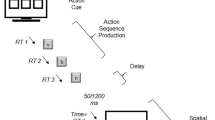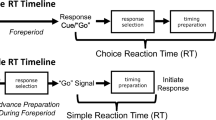Abstract
The effect on reaction time (RT) and movement time (MT) of remembering which one of several targets to move to was investigated in 18 participants who completed 416 trials in each task. On each trial, participants moved their index finger from a central, illuminated switch (the stimulus) to one of eight targets located on the circumference of a 6 cm radius circle. A visual cue (illumination of the target) informed the participant of the appropriate target. In the memorised delay task, the cued target was lit for 300 ms followed by a variable (450–750 ms) foreperiod during which the participant was required to remember the location of the target until the stimulus light was extinguished. In the non-memorised delay task, the target remained lit during the entire foreperiod (750–1050 ms) until the response was completed. At the “go” signal (stimulus light extinguished) participants moved as quickly and accurately as possible to the cued target. Both RT and MT were significantly (p<0.05) longer in the memorised delay task. The increase in RT shows that remembering which target imposed a greater load on motor preparation even though all the information needed for preparing the response was presented in the cue at the beginning of each trial. The increase in MT raises the possibility that movement execution was also programmed during motor preparation.





Similar content being viewed by others
References
Anson JG, Hyland BI, Kotter R, Wickens JR (2000) Parameter precuing and motor preparation. Motor Control 4:221–231
Burle B, Bonnet M (1997) Further argument for the existence of a pacemaker in the human information processing system. Acta Psychol (Amst) 97:129–143
Evarts EV (1968) Relation of pyramidal tract activity to force exerted during voluntary movement. J Neurophysiol 31:14–27
Georgopoulos AP, Caminiti R, Kalaska JF, Massey JT (1983) Spatial coding of movement: a hypothesis concerning the coding of movement direction by motor cortical populations. Exp Brain Res:327–336
Hanes DP, Schall JD (1996) Neural control of voluntary movement initiation. Science 274:427–430
Kahneman D (1973) Attention and effort. Prentice-Hall, Englewood Cliffs, N.J.
Klemmer ET (1956) Time uncertainty in simple reaction time. J Exp Psychol 51:179–184
Labutta RJ, Miles RB, Sanes JN, Hallett M (1994) Motor program memory storage in Parkinson’s disease patients tested with a delayed response task. Mov Disord 9:218–222
Larish DD, Frekany GA (1985) Planning and preparing expected and unexpected movements: Reexamining the relationships of arm, direction, and extent of movement. J Motor Behav 17:168–189
Lepine D, Glencross DJ, Requin J (1989) Some experimental evidence for and against a parametric conception of movement programming. J Exp Psychol Hum Percept Perform 15:347–362
Noteboom JT, Fleshner M, Enoka RM (2001) Activation of the arousal response can impair performance on a simple motor task. J Appl Physiol 91:821–831
Parr-Brownlie L, Wickens J, Anson JG, Hyland B (1998) Does having to remember the position of a target improve reaction time? Motor Control 2:142–147
Riehle A, MacKay WA, Requin J (1994) Are extent and force independent movement parameters? Preparation- and movement-related neuronal activity in the monkey cortex. Exp Brain Res 99:56–74
Roberts AC (1996) Comparison of cognitive function in human and non-human primates. Brain Res Cogn Brain Res 3:319–327
Rosenbaum DA (1980) Human movement initiation: specification of arm, direction, and extent. J Exp Psychol Gen 109:444–474
Rosenbaum DA (1983) The movement precuing technique: assumptions, applications, and extensions. In: Magill RA (ed) Memory and control of action, vol 12. North-Holland, Amsterdam, pp 231–274
Saslow CA (1972) Behavioral definition of minimal reaction time in monkeys. J Exp Anal Behav 18:87–106
Smyrnis N, Taira M, Ashe J, Georgopoulos AP (1992) Motor cortical activity in a memorized delay task. Exp Brain Res 92:139–151
Smyrnis N, Gourtzelidis P, Evdokimidis I (2000) A systematic directional error in 2-D arm movements increases with increasing delay between visual target presentation and movement execution. Exp Brain Res 131:111–120
Spinelli S, Pennanen L, Dettling AC, Feldon J, Higgins GA, Pryce CR (2004) Performance of the marmoset monkey on computerized tasks of attention and working memory. Brain Res Cogn Brain Res 19:123–137
Weed MR, Taffe MA, Polis I, Roberts AC, Robbins TW, Koob GF, Bloom FE, Gold LH (1999) Performance norms for a rhesus monkey neuropsychological testing battery: acquisition and long-term performance. Brain Res Cogn Brain Res 8:185–201
Wickens J, Hyland B, Anson G (1994) Cortical cell assemblies: a possible mechanism for motor programs. J Motor Behav 26:66–82
Zar JH (1999) Biostatistical analysis. Prentice-Hall, London, UK
Author information
Authors and Affiliations
Corresponding author
Rights and permissions
About this article
Cite this article
Jordan, K., Hyland, B.I., Wickens, J.R. et al. Motor preparation in a memorised delay task. Exp Brain Res 166, 102–108 (2005). https://doi.org/10.1007/s00221-005-2348-0
Received:
Accepted:
Published:
Issue Date:
DOI: https://doi.org/10.1007/s00221-005-2348-0




